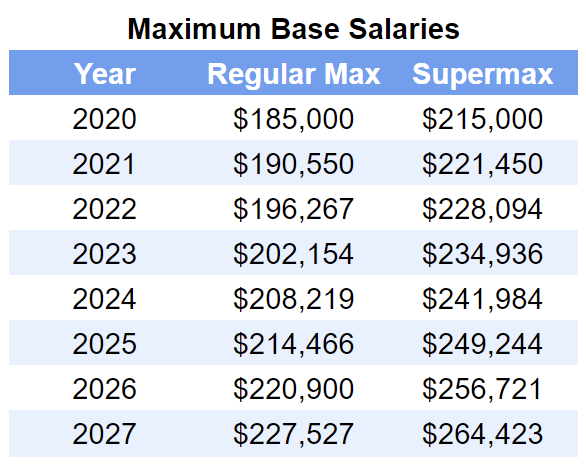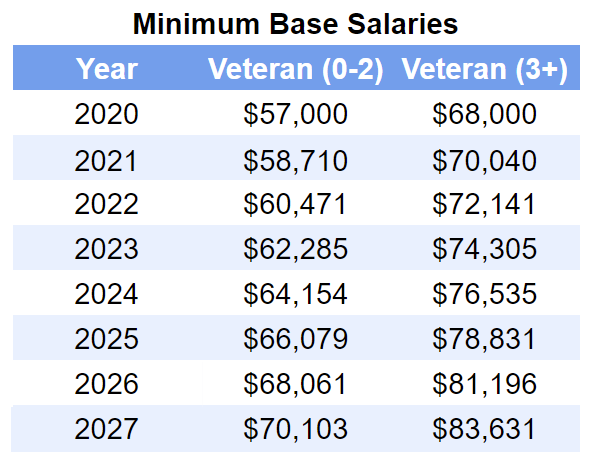WNBA CBA and Salary Cap Explained: Base Salary Basics
Looking at league minimum and maximum base salaries for the WNBA
Thanks for reading the Her Hoop Stats Newsletter. If you like our work, be sure to check out our stats site, our podcast, and our social media accounts on Twitter, Facebook, and Instagram. You can also buy Her Hoop Stats gear, such as laptop stickers, mugs, and shirts!
Haven’t subscribed to the Her Hoop Stats Newsletter yet?
Welcome back to our WNBA CBA and Salary Cap Explained series. As part of our mission to unlock better insight about the women’s game, we’ll be breaking down the rules outlined in the 350-page WNBA Collective Bargaining Agreement (CBA), covering the 2020 through 2027 seasons, in plain language. Each article will focus on a bite-size chunk of the CBA to make the concepts more digestible. We are also compiling all of this information on the Her Hoop Stats website in a single FAQ document.
Missed our previous installments? Here are all the topics we have covered so far…
This is the first of two pieces looking at base salaries. In this installment, we will focus on the minimum and maximum base salary a player can earn in the WNBA. In part two we will look at base salary protections, prorated salaries, and payment schedules.
What is base salary?
Base salary is what is commonly reported as a player’s salary in the media and is, as the name suggests, the base of their total compensation. Players may receive additional compensation from their team or the league, but none of that additional compensation is part of the base salary. There are two tiers of minimum base salary and two different tiers of maximum base salary. Eligibility for each level is governed by the number of years of service a player has among other criteria we will discuss.
How are years of service calculated?
A year of service is counted for every season a player is on the active roster for at least one day of the regular season, with a few exceptions. Players who only play on 7-day or replacement contracts do not earn a year of service. Anyone who holds out for 21 or more days also does not earn a year of service even if they play the rest of the season. There are no partial years of service, players can either earn zero or one.
What is the maximum base salary?
There are two types of maximum base salaries — one standard maximum and a higher maximum for players who meet any of a number of criteria. The higher maximum base salary, which is often referred to as the “supermax”, is designed to reward elite veterans and incentivize young stars to remain with the teams who drafted them. The supermax is about 16% higher than the standard maximum. The standard maximum is for 14.2% of the salary cap and the supermax is for 16.5% of the salary cap.

Who is eligible for a supermax contract?
There are a number of ways players can earn the supermax. The earliest a player can earn a supermax contract is to sign an extension of their rookie-scale contract. As discussed in our Rookie Scale: Extensions & Expiring Contracts article, a player on a rookie-scale contract can sign an extension that will be effective for their fifth year in the league. They can extend their contract for up to three years bringing them to a total of the first seven years of their career. A’ja Wilson will be eligible for such a contract after this season which would take effect in her fifth year in the WNBA, which would be 2022.
Another way to qualify for a supermax contract going forward — effective January 1, 2021 — is to be a free agent with five or more years of service and sign with your prior team. In earlier years, including the current offseason under the new CBA, the requirement was six or more years of service. Free agents designated as a core player by their team are also eligible for the supermax regardless of their years of service. Coring players will be discussed in a later piece.
Finally, veteran extensions can qualify for the supermax if specific criteria are met. A player must have five or more years of service after January 1, 2021 (or six seasons prior to that date) in order to be eligible for the supermax. They also must have been under contract for at least part of each of the two previous seasons. If they played for multiple teams over those two seasons, they must have changed teams via assignment (almost always a trade) or have signed with their most recent team as a free agent during the first season.
Veteran extensions can be for up to 120% of the base salary for the final year of the original contract. As a result, a veteran on a $100,000 contract would be limited to a $120,000 base salary in year one of the extension even if they otherwise qualify for a supermax. Rookie-scale extensions are not limited to the 20% increase to start the extended contract, making them immediately eligible for the supermax in all cases.
Do maximum contracts keep up with the league maximums?
The maximum and supermax base salary limits increase by 3% annually, but this is not true for contracts. The CBA typically limits contracts to an increase equal to 3% of the first year’s salary. This means that a contract signed at the supermax in 2020, like Elena Delle Donne’s, will only match the league’s supermax salary in years one and two.
In year three the supermax will increase by 3% of $221,450 ($6,644) when Delle Donne’s contract will increase by 3% of $215,000 ($6,450). The difference between the supermax and Delle Donne’s salary in 2023 is only $194, but there is a difference.
What is the minimum base salary?
Players with two or fewer years of service are at the lowest level, while players with three or more years of service have a higher minimum base salary. For example, a free agent who played in 2017, 2018, and 2019 such as Erica McCall is governed by the higher minimum base salary.

When does the minimum base salary not apply?
There are a few exceptions to the listed minimum base salary. In our deep dive into rookie-scale contracts, we included the base salary for the length of all contracts. The CBA actually allows for rookie-scale contracts to fall below the league minimum, which only happens in a few situations.
Third-round picks and undrafted players that make it to the second season of their contracts earn about $600 less than the regular minimum base salary for players with one year of service, and third-round picks in the fourth year of their rookie contract will earn about $5,000 less than the regular minimum for players with three years of service.
2020 third-round pick Mikayla Pivec would earn the lowest full-season salary among all players in 2021, $58,141 if she makes the team. Since a standard minimum is $58,710, this is about a 1% difference. In 2023, Pivec would have three years of experience but would earn $69,770 while a veteran contract for a player with three years of service would earn $74,305. That is about a 6% difference.
The other situations where players may earn less than the league minimum in a season are for non-standard contracts like 7-day contracts, rest-of-season contracts, or replacement contracts. These partial season contracts are prorated based on the percentage of days in the season the player is under contract, so by definition, the player will earn less than a full minimum salary. 7-day contracts and rest-of-season contracts use the regular minimums before proration is applied. However, the replacement contract begins at 75% of the regular minimum before proration.
This series is about learning, so we want to hear from you! If you would like a clarification for any rule, suggestions for future CBA Explained topics, or any other questions, please feel free to let us know in the comments or tweet at us @herhoopstats.
Thanks for reading the Her Hoop Stats Newsletter. If you like our work, be sure to check out our stats site, our podcast, and our social media accounts on Twitter, Facebook, and Instagram.



